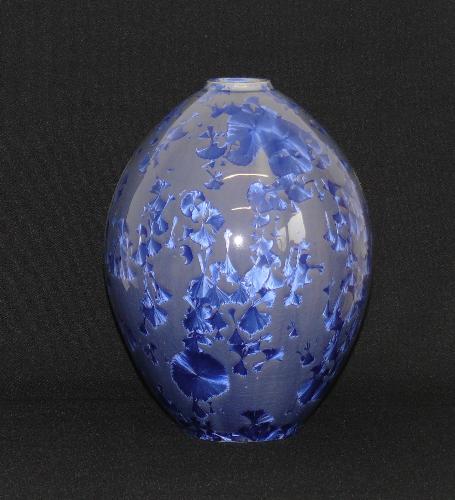 can be
quite frustrating for the potter because they are difficult to create.
can be
quite frustrating for the potter because they are difficult to create.
Macro Crystalline glazes are one of more difficult challenges a ceramist can
face. They are very spectacular and fascinating, but at the same time they
 can be
quite frustrating for the potter because they are difficult to create.
can be
quite frustrating for the potter because they are difficult to create.
There have been two periods in which macro crystalline glazes were popular .
The first period was the second half of the nineteenth century.
Around 1850, companies like Royal Copenhagen and Sevres started with the
production of porcelain with
macro crystalline glazes. Because it was a very difficult process with high failure
rates, after a few decades they stopped with it. Despite the very high prices they were charging for their work
it still was not economical to continue with it.
In the 1960s some studio potters picked up the idea of crystalline glazes again,
and started experimenting with it.
Much more scientific knowledge was available as one hundred years earlier, so
they had a better theoretical understanding of the whole process. That, combined with the
availablity of computer-controlled kilns at the end of the twentieth century
made it possible to get better and more consistent results with the production
of macro crystalline glazes.
Many ceramists think crystalline glazes can only be applied on porcelain clay bodies.
However, it appears that some kinds of stoneware clay can also be used. The
problem with many types of clay is, that the glaze dissolves part of the clay
body. Those dissolved clay ingredients then mix up with the ingredients of the
glaze, and so change the glaze in a way that it does no longer produce crystals.
I work mainly with stoneware clay, and there are some more potters who do. I prefer
the more robust nature and better 'throwability' of stoneware clay over the fragile character of porcelain.
It's just a matter of personal taste.
Crystalline glazes must have a specific composition. They contain between twenty
and thirty percent zinc oxide, about twenty to twenty-five percent quartz, and
often a few percent titanium oxide. And, of course, they contain some colouring
oxides like cobalt, manganese, cupper and others.
When the glaze is applied, the vases are
fired at a temperature between 1250 and 1300 degrees. After reaching the top
temperature I let the kiln cool down to about 1100 degrees, and then I hold that
temperature for several hours.
At top temperature the glaze gets very fluid. During cooling down at about
1100 degrees (between 1050 and 1150),
the
glaze
starts to solidify.
During this solidification process, if all goes well, the crystals grow like
frost flowers on a window in winter. By keeping the temperature in that
solidification area for a for a longer or shorter time, you can influence the
sizie of the crystals.
The heating process, the peak temperature and the temperature at which the crystals grow are different for each glaze composition. Developing a combination of a glaze recepe and a firing schedule which produces beautiful crystals, requires not only theoretical knowledge but also a lot of testing.
|
|
| Glaze tests. Note the form of the test tiles, prohibiting the runny glaze to reach the kiln shelve. |
A practical problem is that these glazes are very fluid at peak temperature. A considerable part of the glaze flows off the pot. In order to prevent that that glaze ruins the kiln plate, the pots must be put on 'catchers' during firing.
|
|
| Dish, ring and vase. The ring has to have exactly the same diameter as the vase bottom. When the glaze becoms extremely fluid at peak temperature, it flows on the dish and not on the kiln shelve |
After firing, the the catcher must be separated from the pot. This is done with a hammer and a chisel (There are other methods such as heating the join between vase and catcher with a gas burner, but this is how I do it). Then the bottom of the pot should be grinded with a grinding wheel because the broken glaze edge is razor sharp.
|
|
| Removing the catcher with a hammer and a chissel. Note the glaze which runned off the pot in the catcher! |